
The Natural Georgia Series: The Okefenokee Swamp

 |
The Natural Georgia Series: The Okefenokee Swamp |
 |
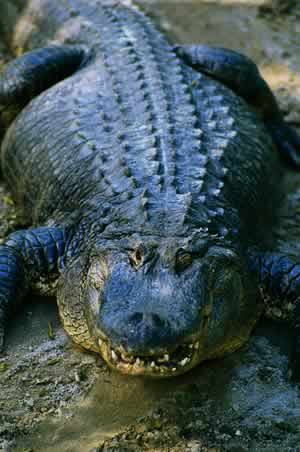
Deep from within the dark, murky depths of the Okefenokee Swamp echoes a deep-throated,
bellowing call. The low sound reverberates across acres of wetland habitat -
past forests of moss-draped cypresses, through wet prairies of lilies and grasses,
and over shallow ponds - from an animal in search of a mate who will respond
to its beckoning. It's springtime, and the eery calls are common cries from
the closest living relative of the dinosaurs, the American alligator.
With its dark, dragon-like skin, long muscular tail, and powerful jaws, the
alligator is somewhat of a modern dinosaur, having changed little since the
crocodilians first appeared 160 million years ago. Alligators stem from the
archosaurs, the dominant reptiles of the Triassic period millions of years ago.
Today, there are 21 species of crocodilians found throughout the world. Georgia
is home to only one, the American alligator (Alligator mississippiensis).
Only two other species occur in North America - the native American crocodile
(Crocodylus acutus ) found in extreme southern Florida and the
spectacled caiman (Caiman crocodilus ), an introduced species.
Alligators and crocodiles are often mistaken for each other, but there are
a few distinguishing characteristics by which to tell them apart. For one, a
crocodile's jaw when closed exposes a few teeth, whereas the closed mouth of
the alligator won't reveal any. A crocodile's snout is also much narrower and
longer than that of an alligator whose snout is more round. The habitat of these
two species differs, as well. Crocodiles, preferring saltwater or brackish habitats,
are found in coastal areas. Alligators are mainly found in freshwater regions
including swamps, ponds, or rivers, and occasionally brackish water.
The majority of Georgia's alligators are found in the largest freshwater refuge
east of the Mississippi River, the Okefenokee Swamp. In fact, an estimated 10,000-13,000
gators are thought to be living in the 396,000 acres of the Okefenokee National
Wildlife Refuge.
"We conduct an indicator survey at the end of each summer to give us
an estimate of the number of alligators in the swamp," said Maggie O'Connell,
a ranger with the Okefenokee National Wildlife Refuge (NWR).
The survey is conducted after dark. Rangers use spotlights to search for the
nocturnal creatures, counting the pairs of red eyes belonging to the gators.
By using a unique formula, they can also guess the size of the gators.
"We can estimate an alligator's length by estimating the distance between
the nose and eyes and substituting feet for inches," said O'Connell.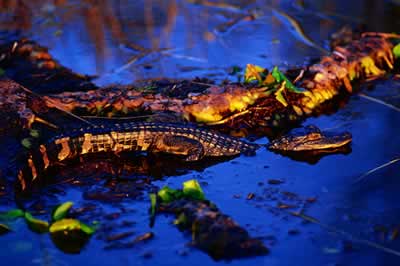
Gator populations have remained stable in the swamp over the past few years.
Their population is also distributed evenly, for the most part, throughout the
swamp.
The Okefenokee isn't the only area occupied by gators, though. From the brackish
waters of coastal estuaries to an entourage of ponds, rivers, and streams, Georgia's
gators are scattered throughout south Georgia. Lake Seminole and coastal Georgia
have a dense population of gators. Gators can also be found in some less likely
locations such as farm ponds and suburban backyards.
The distribution range of alligators in Georgia has changed very little over
the past several decades. While alligators have increased in number, the areas
they occupy have remained virtually the same. Georgia's alligators can be found
primarily south of the fall line (roughly from Columbus to Macon to Augusta),
their natural geographic range in this state. The range has extended above the
fall line just a little with some gators occurring in Harris County and others
just north of Augusta. There are even a few gators in Atlanta and northwest
Georgia from time to time, but these are a result of people transplanting them.
Although gators are cute when they're young and seem fun to take home, they
grow quickly, losing their appeal as a pet, and former pet owners sometimes
release gators into the wilds of a metropolitan area. Thus, gators occasionally
show up where they don't belong.
The name "alligator" is derived from "el lagarto" (the lizard),
a term given to these large reptiles by the Spaniards when they first discovered
them in Florida. The large lizards are today known as North America's largest
reptile. Male gators average 11-12 feet long and weigh between 400 and 500 pounds.
Females follow close behind, averaging 8-9 feet in length. The largest gator
ever recorded, however, was a 19-foot-2-inch-long male found in Louisiana back
in the early 1900s. Large gators like the record in Louisiana are often believed
to be hundreds of years old because of their immense size and strength. In reality,
though, the life span of a gator is about 30-35 years in the wild or 50 years
in captivity.
Alligators are covered with a thick, tough skin, and their backs are covered
with protective bony plates called scutes. A myth dating back to the Native
American era asserts that gators had special powers including an immunity to
the venom of poisonous snakes. Native Americans collected the teeth of alligators
believing them to be a magical ward against snakebites. Although alligators
are not immune to snake venom, the thick texture of the skin may prevent a snake's
fangs from penetrating it, thus protecting it from the poison.
Alligators are primarily nocturnal, hunting at night and preying on a variety
of animals. Despite their slow-moving appearance, they are extremely agile and
can exert sudden bursts of speed to succumb their prey. Their powerful jaws,
with a crushing power of 3,000 pounds per square inch per snap, can easily break
the bones of an animal or crush the shell of a turtle. A large male alligator
is fully capable of taking a large deer or even a bear if it can get it to the
water to drown it. Their conical-shaped teeth are made for holding onto prey
not cutting it. As a result, most alligators swallow their prey whole. Yet,
by twisting its body from side to side, a gator can tear pieces of its dinner
into portions small enough to swallow. Despite the abilities of this incredible
predator, most gators, like numerous other large predators, mainly hunt prey
that will give them the least trouble. Small, weak animals are often sought
out.
"Alligators mostly feed on fish, turtles, mice, muskrats and birds,"
said Howard Hunt, Curator of Reptiles at Zoo Atlanta. "I've even seen adults
go after grasshoppers and millipedes before."
The type of food ingested also depends on the size of the gator. Young gators
often feed on snails, frogs, insects and small fish. Larger gators prey on larger
animals and will even attack another gator if the opportunity avails itself.
Gators also make use of carrion. Some rather unusual items, such as stones,
sticks, cans, fishing lures and other objects have also been ingested by the
great predators, a reminder of the pollution in our waterways.
Sexual maturity is dependent on the size of the gator and is usually attained
at six feet when the gator is approximately 10-12 years old. The courtship ritual
is rather elaborate and begins with bellowing in the early spring. Both males
and females may bellow, letting members of the opposite sex know of their presence.
Bellows can be heard all through the swamp during warm months and may occur
outside of courtship as well. Another common courtship ritual is known as head-slapping,
where gators literally slap their heads on the water, producing another type
of echoing sound. Head-slapping, said Hunt, not only tells the location of the
gator, but also says something about the size of the gator, an important message
to prospective mates.
The territories of males are larger than those of females, and one male territory
may cross over that of several females, allowing him the opportunity to mate
multiple times. After mating, the female begins building a nest in the marshy
areas on higher ground, to prevent the risk of flooding which could kill all
of the eggs. She builds the nest with her hind feet, tail, and snout, using
mud, grass, and leaf litter. Mounds may be up to 6 feet wide and 3 feet high.
She digs a hole in the top of the mound and deposits 20-50 eggs, usually in
June. The whole nest-building process may take two to three days, but her job
is far from over. The female guards the nest from predators for the next 65
to 70 days as the eggs incubate. Animals approaching the nest will receive an
unwelcome greeting of hisses, lunges, and even attacks from the protective mother.
Raccoons are the heaviest predators of alligator nests and can completely destroy
a nest and its contents if not stopped.
Heat produced from the decaying vegetation in the nest incubates the eggs.
The sex of a gator is determined by the temperature at which the egg is incubated.
Eggs incubated at temperatures of 86 degrees Fahrenheit or below will hatch
as females, while those at or above 93 degrees Fahrenheit will be males. When
the young gators are ready to hatch, they make a high-pitched barking sound.
The mother, upon hearing the call, opens the nest which has hardened in the
dry heat of the sun, freeing the hatchlings. She may also help the hatchlings
break free from their eggs and sometimes carries the young in her mouth to the
water.
The young 8- to 10-inch alligators, adorned with bright stripes and yellow
blotches, stay close to their mother and the nest for their first couple of
years. The young gators also remain in a tight group, known as a pod. Because
they are an easy meal for raccoons, large fish, birds, and other predators of
any substantial size in the swamp, the first few years of a young alligator's
life are the most treacherous. Only by sticking together can they help ward
off potential predators. When threatened, members of a pod emit a distress call.
A female, not necessarily the mother in every case, hearing the call can locate
the pod quickly and run off the predator. Adult females are essentially the
only form of protection young gators have, and mothers will protect their young
until the next breeding season.
Throughout its life cycle, alligators play a vital role in wetland ecosystems.
Gators manipulate their environment by digging and building nests, burrows,
and holes. These creations not only benefit the gator but an array of other
wildlife species as well.
Gator holes are possibly the greatest contribution made by alligators to their
environment. A gator hole is a large, deep hole dug out by the gator to provide
water during dry spells. Gator holes are often critical to the survival of a
number of species as they may be the only source of water in an area during
a drought. A variety of wildlife will utilize the hole, and the importance of
the water outweighs the increased chance that the animal may become prey of
the alligator.
Burrows, which alligators dig primarily as a refuge from cold temperatures
during winter months, also provide protection for an array of wildlife species.
The burrows are used in warmer months as well, and Hunt has known of underwater
den connections used in the middle of the summer to go from one area of the
swamp to another. These burrows, like the gator holes, are used by a multitude
of species like turtles, water moccasins, and otters. Sometimes the burrows
can have detrimental effects on the young gators by allowing predators such
as otters an opportunity to prey on the young in the winter when the mother
gator is too inactive to protect her offspring.
Through building nests and refuges, alligators can almost transform a wetland,
having a collective effect on the landscape.
"If you look down on the Okefenokee Swamp, you can see an intricate maze created by the alligators. There are trails and pathways leading to the water, nest mounds, and caves, and you can see where they have cleared out surface vegetation," said Hunt.
There was a time when alligators had come so close to extinction that their
critical link in the ecosystem could have been lost forever. Georgia's alligator
population first began to plummet in the mid 1960s, according to Steve Ruckel,
who served as the state alligator biologist for the Georgia Department of Natural
Resources (DNR) up until 1995. The cause for decline was habitat loss and poaching.
Georgia's hunting seasons were also beginning to take a toll on the species.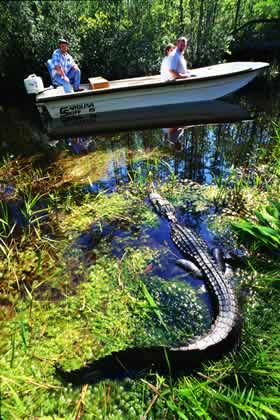
"Illegal hunting combined with legal hunting that was too wide open and
not closely regulated brought the population down," said Ruckel.
Alligator hides had been a valuable commodity even back in the Native American
era when they used the skins to make drums. Later, hides were valued for a wide
range of leather items, including boots, wallets, purses, shoes, and briefcases.
The demand took a toll on the species, however, and between 1870 and 1970, an
estimated 10 million alligators were killed in Florida alone. By 1973, the vast
alligator population was almost totally depleted, and serious action was needed.
The American alligator was listed as endangered on both the state and federal
endangered species lists.
Alligators remained on Georgia's Protected Species List until 1984. The protection
during this time allowed the species time to recover. By the late 1970s, the
species was well on its way to recovery, and by the 1980s, the population really
boomed. In 1987 alligators had recovered enough to justify a reclassification
on the federal list as threatened by similarity of appearance throughout its
range.
The American alligator continues to be listed as threatened by similarity
of appearance in an effort to protect crocodilians that are still critically
endangered in other parts of the world. Because of the resemblance between skins
of different crocodilians, international trade of alligator skins is highly
regulated. The U.S. Fish and Wildlife Service (USFWS) is involved with the importation
and exportation of the skins. A special tag known as the CITES (Congress of
International Trade for Endangered Species) tag is required for the international
trade of alligator skins and must remain attached to the skin up through the
tanning process.
Beyond that, the USFWS has little to do with alligators. Management of the
species has been turned over to the states. In Georgia, management has occurred
mainly in the form of spotlight counts and helicopter surveys to determine alligator
populations. These surveys provide little more than index figures, however,
because of the difficulty of the survey and the unreliable estimates made in
the early years. As a result, the surveys mainly indicate if the alligator population
has increased, stabilized, or decreased from last year's numbers.
Illegal hunting for the hides and meat of gators is currently very rare. Even
the Okefenokee Swamp with its huge gator population has recently seen no evidence
of poaching. The legal business of breeding alligators for their hides and meat,
however, is a growing industry. Georgia has 10 alligator farms in operation
located in south Georgia. The facilities breed gators for their hides and meat
which are sold.
One of these gator farms, Low Country Gators in Brunswick, has about 800 gators
at any one time on its premises. The facility consists of breeding ponds and
hot houses, or environmental chambers, where the gators are raised.
According to R.L. Holtzendorf, who founded Low Country Gators nine years ago,
the hot houses are very similar to chicken houses, only those at Low Country
Gators are round in shape to prevent the gators from smothering themselves if
they get backed up in a corner. The hot houses also have a concave-shaped floor
with a drain in the middle of it. Every day the "pool" is refilled
with warm water. It is large enough that all of the gators in the house can
be in the water or out, as required by the DNR which permits these operations.
A constant high temperature of 88-90 degrees must also be maintained in the
hot houses, hence the name. Gators grow in the houses for two years, as compared
to chickens which attain full growth in just seven weeks.
Each breeding pond consists of one male and three females. Each summer, eggs
laid by the females are removed from the nests and placed in incubators kept
at 90 degrees, providing Holtzendorf with mostly males to raise.
"Males grow faster and get larger than the females," said Holtzendorf.
If all goes well, the captive male gators will obtain lengths of about 10-12
feet during their short life spans. However, stress, even in the life of a gator,
can have its effects.
"The biggest problem with them not growing is stress," said Holtzendorf.
"We must wash out the pens every day, keeping them clean, maintain a steady
water level and keep the noise level down. Even having different people care
for them can have an effect on them. Some farmers even keep music playing all
the time, over and over, to drown out other noises."
Holtzendorf doesn't go that far, but he does feed his gators well to raise
the best quality gators possible. He adds a vitamin-mineral mixture and extra
calcium to their feed, which consists of packaged alligator chow and beef and
chicken from packing houses.
These days, a gator hide will bring in about $35 a foot. Eight or nine years
ago, it would have made $50 to $55 a foot. There is a bigger supply now that
more people are into gator farming, making alligator products less valuable
than before.
Like gator farms, gator populations in the wild have also grown. As alligators
have recovered in the state, the opportunity for human contact with them has
increased as well. Gators are not naturally a threat to humans, but they can
move around a good bit, especially in the summer months during breeding and
nesting seasons. They don't necessarily follow a river or stream and can be
found far from any type of water source, which can bring them into some unpredictable
places. 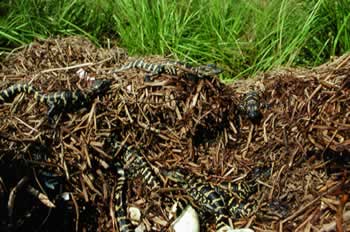
Because of the increase in the number of gators and their tendency to move
around, conflicts with humans are inevitable. The loss of habitat, especially
wetlands, is also a contributing factor, forcing gators into areas not usually
defined as alligator habitat, like farm ponds, swimming pools, or subdivision
lakes.
Just placing an alligator in human populated areas, however, is not an immediate
cause for alarm. Alligators are typically wary of humans and will avoid contact,
as observed by Joe Hall with the Okefenokee Swamp Park, a nonprofit facility
located at the northern entrance to the swamp near Waycross. The park, which
has captive gators on exhibit, is also known as the home of Oscar, a wild 15-foot
gator weighing about half a ton and possibly the most well-known gator of the
Okefenokee. Oscar along with many other wild alligators are frequent visitors
to the park.
"We often have wild gators in the park where our visitors are, but the
gators pretty much ignore us. They really don't feel threatened," said
Hall.
At the park, wild gators may be seen basking in the parking lot and have been
mistaken for a statue instead of a live alligator. Obviously, humans have come
into very close contact with the gators; luckily, no one has ever been attacked.
In cases where humans are attacked, the gator usually acts in defense. Most
attacks also occur in the water, although a female gator will often vehemently
defend a nest by hissing and lunging toward a human who has gotten too close.
If the human continues to advance, he or she could be bitten.
One of the main causes for conflicts between humans and gators, however, is
people feeding them, a problem so widespread that it is now illegal in the state.
People with a gator in their area may think its fun to feed at first but usually
think otherwise after a while.
"The gator they started feeding two years ago is now a 6-foot gator,"
said Greg Waters, DNR Wildlife Biologist. "The alligator approaches people
expecting to be fed."
When alligators begin associating people with food, they may follow boats,
take fish right off a fisherman's line or worse.
The Okefenokee Swamp with its 400,000 visitors each year has had particular
problems with guests feeding the gators and have prohibited the feeding, as
well.
"Feeding the gators makes them much more likely to hang around and lose
their fear of humans," said O'Connell.
Rangers with the Okefenokee NWR have had to relocate a gator for exactly that
reason. The gator had to be moved to another section of the swamp not for something
it did, but because of visitors' impact on it.
The Okefenokee NWR also doesn't allow dogs or pets in boats in the swamp.
Any pet that enters the refuge area must be kept on leash at all times, a measure
to protect the pets. According to O'Connell, dogs especially tend to attract
alligators, probably because dogs are identified by the gators as prey.
Gator attacks on humans, according to Waters, are quite minimal in Georgia.
In the past three to four years, there were only three recorded attacks on humans.
Of these, none were fatal, and the majority didn't result in the loss of a limb.
Fatalities from gator attacks are very uncommon. Hunt reported that only eight
to nine people have ever been killed in Florida from a gator attack. For a state
where there are immense numbers of alligators and people, these statistics are
quite minimal. He also noted that an alligator has never gone after several
people at one time. Gators avoid crowds.
Alligator attacks in the wild are rare. Abnormal incidents do occur, however,
such as an incident on Ossabaw Island where a wildlife biologist, who was making
grunting calls similar to that of young gators while splashing his fingers in
the water, was attacked by an adult submerged directly in front of him. Luckily,
the biologist was able to poke the gator's eye with his free hand until it released
and escape with only minor injuries.
The Ossabaw incident is not an example of a normal, everyday occurrence. A
gator would not normally attack a human unless it had been fed by humans and
had lost its fear of them. If a gator associates humans with food, however,
then a person along a bank calling a gator may be nothing more to the gator
than a dinner bell.
Although situations like the above case are rare, there are incidences where
an alligator can be a threat to people. As a result, the DNR in 1989 established
a Nuisance Alligator Program. Through the program, individuals who believe they
have a nuisance gator contact the DNR which then sends out a wildlife biologist
for confirmation. A nuisance gator is defined as a gator more than 4 feet long
which is occupying an unnatural location or having conflicts with humans at
a natural location. If the gator is not considered a "nuisance" gator
or one causing danger, the biologist generally tries to calm the fears of the
property owner or people in the area so that the gator will not have to be moved.
In cases where the gators are declared a nuisance, the DNR contacts licensed
trappers on contract with the DNR who have 30 days to remove the nuisance gator.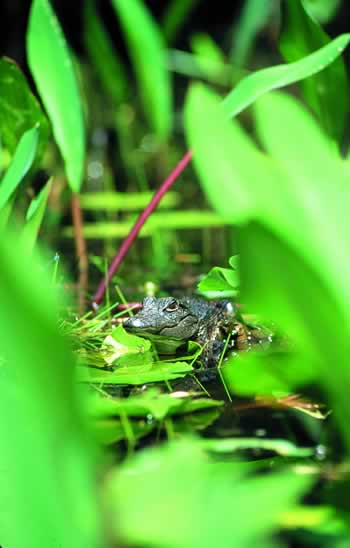
There are 14 trappers currently involved in the program. Each of the trappers
is on contract with the DNR and receives no payment from the DNR for the trapping.
Instead, the trappers may recoup costs by selling the hides and meat of the
gators they received permits to catch.
Trappers are required to have a Georgia trapping license which must be renewed
annually. The only other requirements of the trappers are that they cannot go
out with a firearm to shoot the gator, and they must take into account public
safety at all times, being as discreet as possible.
Methods for trapping gators vary between individuals but may include a long
pole and snare, a harpoon with a line attached, a large baited rod 'n reel,
or a net. Trapper Jeffrey Shepherd of Dublin even has a live trap but prefers
to use a snare.
"I get to the pond around dusk to look at the pond and try to see the
gator and call the gator up," said Shepherd. "Calling works real well
on females and sometimes males."
Shepherd, who covers the largest area for a Georgia alligator trapper (14
counties in central Georgia), averages about 35 calls per year and catches 20-25
gators, which average about 8 feet in length. In other areas where alligators
are more plentiful, a trapper may receive as many as 100 calls. Shepherd relocates
most of the gators he catches to a more natural habitat where conflicts with
humans are less likely.
"Gators do more good for a pond than harm; they eat turtles and snakes,"
he said. "I don't feel they're much harm, not if you respect them."
The number of nuisance gator reports has grown steadily in accordance with
the alligators' recovery over the years. Over the last five years, it has fluctuated
very little. In 1995, the number of complaints received by the DNR totaled 552.
In response to these complaints, 541 gators averaging a length of 7 feet and
a weight of 99 pounds were captured by trappers.
Despite the fact that gators have recovered in Georgia there is no hunting
season for them at this time.
"There is a framework set up in the regulations for a hunting season,
but to date there is no hunt," said Waters. "It is possible in the
future that a limited harvest will be set."
Other states which offer alligator hunts include Louisiana, Texas, Florida,
and South Carolina. Alabama has a nuisance program similar to Georgia's.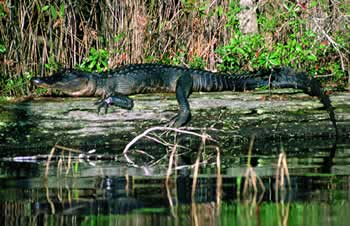
Setting up a hunting season and managing it effectively is a bigger job than
one might expect. It is also an extremely time-consuming venture for the DNR,
because of the necessary species inventories required and the issuing of permits.
Although there is a possibility of having some kind of alligator season in the
future, Ruckel does not expect it to be an open season in every county. Instead
he predicts a limited take offered in areas where alligator populations are
concentrated such as Lake Seminole and coastal areas.
"Their reproductive capacity is not like deer and turkey," said
Ruckel. "If you make an error with them, they'll need a longer time to
recover. So we'll be more conservative in their management."
The future for Georgia's alligators is unpredictable. Although they have survived
thus far, there are still some factors not in their favor. Habitat loss is continuing
at an alarming rate, forcing gators into smaller and smaller areas. Their survival
will depend on the number of prey available to them. Pollution is also a factor.
Alligators are subject to pollution because they live a long time. Heavy metals
and pesticides can become concentrated in the tissues of a predator, affecting
their longevity and reproductive productivity.
Alligators have come a long way in the 160 million years they have existed. They have proven to be resilient creatures determined to survive. If Georgians can continue to respect these creatures, then both gators and humans can coexist in Georgia for years to come.
Read and add comments about this page
Go back to previous page. Go to Okefenokee Swamp contents page. Go to Sherpa Guides home.
[ Previous Topic | Next Topic ]